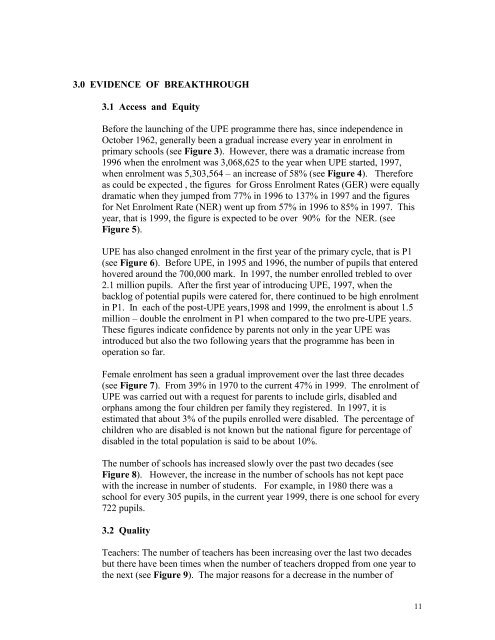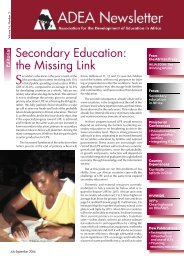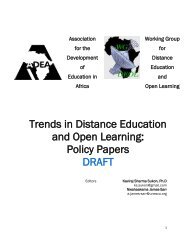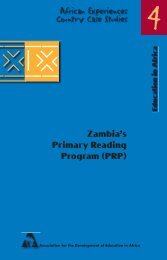the ugandan experience of universal primary education (upe) - ADEA
the ugandan experience of universal primary education (upe) - ADEA
the ugandan experience of universal primary education (upe) - ADEA
Create successful ePaper yourself
Turn your PDF publications into a flip-book with our unique Google optimized e-Paper software.
3.0 EVIDENCE OF BREAKTHROUGH<br />
3.1 Access and Equity<br />
Before <strong>the</strong> launching <strong>of</strong> <strong>the</strong> UPE programme <strong>the</strong>re has, since independence in<br />
October 1962, generally been a gradual increase every year in enrolment in<br />
<strong>primary</strong> schools (see Figure 3). However, <strong>the</strong>re was a dramatic increase from<br />
1996 when <strong>the</strong> enrolment was 3,068,625 to <strong>the</strong> year when UPE started, 1997,<br />
when enrolment was 5,303,564 – an increase <strong>of</strong> 58% (see Figure 4). Therefore<br />
as could be expected , <strong>the</strong> figures for Gross Enrolment Rates (GER) were equally<br />
dramatic when <strong>the</strong>y jumped from 77% in 1996 to 137% in 1997 and <strong>the</strong> figures<br />
for Net Enrolment Rate (NER) went up from 57% in 1996 to 85% in 1997. This<br />
year, that is 1999, <strong>the</strong> figure is expected to be over 90% for <strong>the</strong> NER. (see<br />
Figure 5).<br />
UPE has also changed enrolment in <strong>the</strong> first year <strong>of</strong> <strong>the</strong> <strong>primary</strong> cycle, that is P1<br />
(see Figure 6). Before UPE, in 1995 and 1996, <strong>the</strong> number <strong>of</strong> pupils that entered<br />
hovered around <strong>the</strong> 700,000 mark. In 1997, <strong>the</strong> number enrolled trebled to over<br />
2.1 million pupils. After <strong>the</strong> first year <strong>of</strong> introducing UPE, 1997, when <strong>the</strong><br />
backlog <strong>of</strong> potential pupils were catered for, <strong>the</strong>re continued to be high enrolment<br />
in P1. In each <strong>of</strong> <strong>the</strong> post-UPE years,1998 and 1999, <strong>the</strong> enrolment is about 1.5<br />
million – double <strong>the</strong> enrolment in P1 when compared to <strong>the</strong> two pre-UPE years.<br />
These figures indicate confidence by parents not only in <strong>the</strong> year UPE was<br />
introduced but also <strong>the</strong> two following years that <strong>the</strong> programme has been in<br />
operation so far.<br />
Female enrolment has seen a gradual improvement over <strong>the</strong> last three decades<br />
(see Figure 7). From 39% in 1970 to <strong>the</strong> current 47% in 1999. The enrolment <strong>of</strong><br />
UPE was carried out with a request for parents to include girls, disabled and<br />
orphans among <strong>the</strong> four children per family <strong>the</strong>y registered. In 1997, it is<br />
estimated that about 3% <strong>of</strong> <strong>the</strong> pupils enrolled were disabled. The percentage <strong>of</strong><br />
children who are disabled is not known but <strong>the</strong> national figure for percentage <strong>of</strong><br />
disabled in <strong>the</strong> total population is said to be about 10%.<br />
The number <strong>of</strong> schools has increased slowly over <strong>the</strong> past two decades (see<br />
Figure 8). However, <strong>the</strong> increase in <strong>the</strong> number <strong>of</strong> schools has not kept pace<br />
with <strong>the</strong> increase in number <strong>of</strong> students. For example, in 1980 <strong>the</strong>re was a<br />
school for every 305 pupils, in <strong>the</strong> current year 1999, <strong>the</strong>re is one school for every<br />
722 pupils.<br />
3.2 Quality<br />
Teachers: The number <strong>of</strong> teachers has been increasing over <strong>the</strong> last two decades<br />
but <strong>the</strong>re have been times when <strong>the</strong> number <strong>of</strong> teachers dropped from one year to<br />
<strong>the</strong> next (see Figure 9). The major reasons for a decrease in <strong>the</strong> number <strong>of</strong><br />
11

















